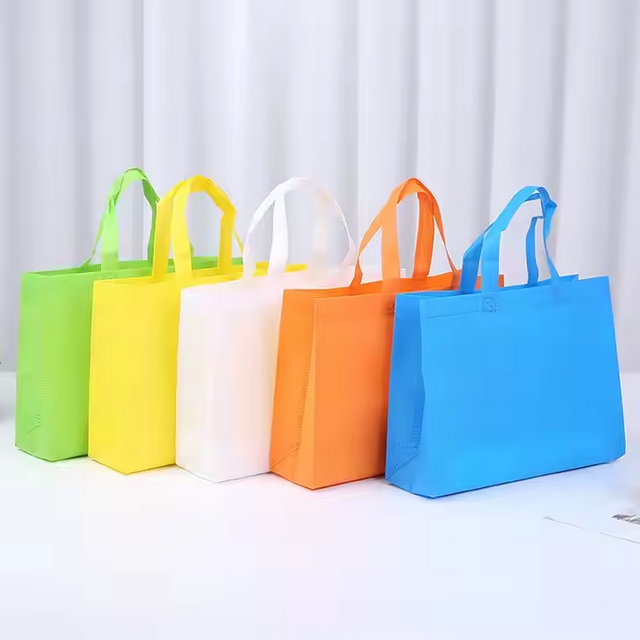As global demand for sustainable packaging grows, professionals like you search for answers to critical questions:
• What is the difference between a woven and non-woven bag?
• What are non-woven bags made of?
• Are non-woven bags truly biodegradable?
At NW Fabric, we specialize in non-woven solutions. This definitive guide cuts through the confusion with data-driven insights for informed business decisions.

1. Core Distinction: Manufacturing Process
The fundamental difference lies in production technology:
| Factor | Woven Bags | Non-Woven Bags |
|---|---|---|
| Production Method | Extruded PP tapes woven on looms | PP fibers bonded mechanically/thermally |
| Structure | Visible grid-like pattern | Uniform felt-like surface |
| Key Visual Cue | Individual threads detectable | Seamless fiber matrix |
Technical Insight: Non-woven fabrics skip spinning/weaving entirely. Fibers are laid randomly or directionally, then fused – making them faster to produce than woven alternatives.
2. Non-Woven Bag Materials Decoded
Answering “What are non-woven bags made of?“:
- Primary Material: Polypropylene (PP)
Used in 90%+ commercial non-woven bags due to:
• Cost efficiency & lightweight durability
• Excellent printability for branding
• Water resistance & recyclability potential - Production Process:
PP pellets → Melt extrusion → Filament spinning → Web formation → Thermal bonding → Fabric rolls - Advanced Variations:
• rPP: Bags with 30-80% recycled content
• PET blends: For enhanced tear resistance
• Bio-based additives: PLA/starch compounds (requires industrial composting)
NW Fabric Advantage: We engineer custom PP blends with UV stabilizers, colorants, and recycled content – optimizing performance while reducing environmental footprint. If you are looking for pp nonwoven fabric,please contact us.
3. Advantages vs Disadvantages: Evidence-Based Analysis
Benefits Driving Adoption:
✓ Economic Efficiency: 30-50% lower production costs vs woven bags
✓ Branding Superiority: High-resolution print surfaces for logos
✓ Functional Versatility: Water resistance + breathability options
✓ Reusability: Withstands 50+ uses (per European Plastics Converters study)
✓ Customization: Easily die-cut for handles/shape variations
Critical Limitations:
✗ Load Capacity: Max 15-20kg vs 50kg+ for woven counterparts
✗ Abrasion Sensitivity: Surface fibers may pill under heavy friction
✗ Recycling Gaps: Only 10-15% enter recycling streams globally
✗ Misleading Eco-claims: “Biodegradable” requires certification verification
4. The Biodegradability Reality Check
Directly addressing “Are non woven bags biodegradable?“:
Standard PP non-woven bags DO NOT biodegrade in natural environments.
Clarifying Common Misconceptions:
- Myth: “Non-woven = Biodegradable”
Fact: PP decomposes into microplastics over 20-30 years - Truth About Compostables:
Certified compostable bags (e.g., EN 13432) require:
• Industrial composting facilities (55-60°C)
• 12-week decomposition timeline
• Significant cost premium (2-3x standard PP) - Sustainable Pathways:
→ Prioritize reusability (50+ cycles to offset carbon footprint)
→ Specify recycled content (rPP reduces virgin plastic use)
→ Implement take-back programs for material recovery
5. Strategic Selection Guide
When to choose non-woven:
- Promotional tote bags < 15kg capacity
- Retail packaging requiring premium print finishes
- Reusable shopping systems with recycling infrastructure
Opt for woven when:
- Transporting construction materials or heavy goods
- Extreme abrasion resistance is critical
- Ventilated agricultural packaging is needed
Conclusion: Making Responsible Choices
Non-woven PP bags deliver unmatched cost-to-performance value for branding and light-duty use, provided they’re reused extensively and properly recycled. While not inherently biodegradable, their environmental impact can be minimized through:
- Smart material selection (rPP/bio-blends)
- Design-for-recycling principles
- Consumer education programs
